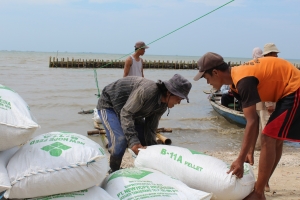Nature Lovers return mangroves to Pulau Dua
Location: Pulau Dua, Indonesia. 28th Aug 2017
Mangroves act as a natural barrier between land and sea and prevent coastal erosion. They also provide shelter for marine wildlife.
Udin is one of many fishermen in the area who suffered the aftermath. Seawater intrusion contaminated fresh water in his village and the lack of mangroves meant that he had to go far away from the shore to fish, reducing his income. To fulfill his basic needs, Udin was desperately looking for other jobs in nearby towns.
Realising that restoring mangrove forests would bring economic benefits to communities, like increased fish catches and mangrove branches for daily use, Udin and his friends teamed up with Pulau Dua Nature Reserve staff to plant mangroves on the coast. With limited resources, Udin and his friends hand-nurtured the mangroves, and after one year they were already protecting Pulau Dua Nature Reserve from harsh winds and waves.
This initiative, which Udin calls The Nature Lovers, or Kelompok Pecinta Alam Pulau Dua (KPAPPD), and their intent to restore mangrove forests did not go unnoticed. In 2013, KPAPPD, with the support of Wetlands International Indonesia (WII), started to plant mangroves along abandoned fishponds which they used to cultivate milkfish and shrimp, a technique known as sylvo-fishery. In 2014, KPAPPD tried an innovative technique in the buffer zone of Pulau Dua; A semipermeable barrier made of tree branches, sand bags and nets was set up to trap mud and sediment against the shore, providing a place for mangroves to grow.
Despite this success, KPAPPD could only protect a small part of the nature reserve, due to a limited budget. In February 2016, MFF provided KPAPPD with a grant to build semipermeable barriers on other parts of Pulau Dua. By November 2016, the sedimentation was almost one meter and 1,500 mangrove seedlings were planted in January 2017.
The wives of KPAPPD members and other women in the village also formed a group. They received training from MFF in fish cracker and milkfish stick production, and subsequently generated approximately US $118 per month from product sales. The women used this income to buy extra food for the family and pay their children’s tuition.
The mangrove restoration and sylvo-fishery has attracted eco-tourists and generated additional income for KPAPPD and Pulau Dua is becoming a learning site where local government and NGOs can learn how to make the semipermeable barriers. KPAPPD has also been invited to meetings and training events to share their mangrove restoration techniques and success stories.
Udin has boundless enthusiasm to improve local communities and the environment. “We can always do more with what we’ve got,” he says, “and the MFF programme activities have absolutely increased my passion for society and nature.” He and his group will continue building semipermeable barriers and restoring mangrove forest along the coastline of Pulau Dua. Udin will also continue to raise awareness about the importance of mangroves for the communities’ livelihoods.
This story was contributed by Telly Kurniasari, National Coordinator for Indonesia. Telly drafted the piece following the IUCN Asia Strategic Communications for Conservation Workshop in Bangkok, Thailand, which took place in July.

KPAPPD builds semipermeable barriers in Pulau Dua, Pulau Dua, Indonesia © MFF Indonesia